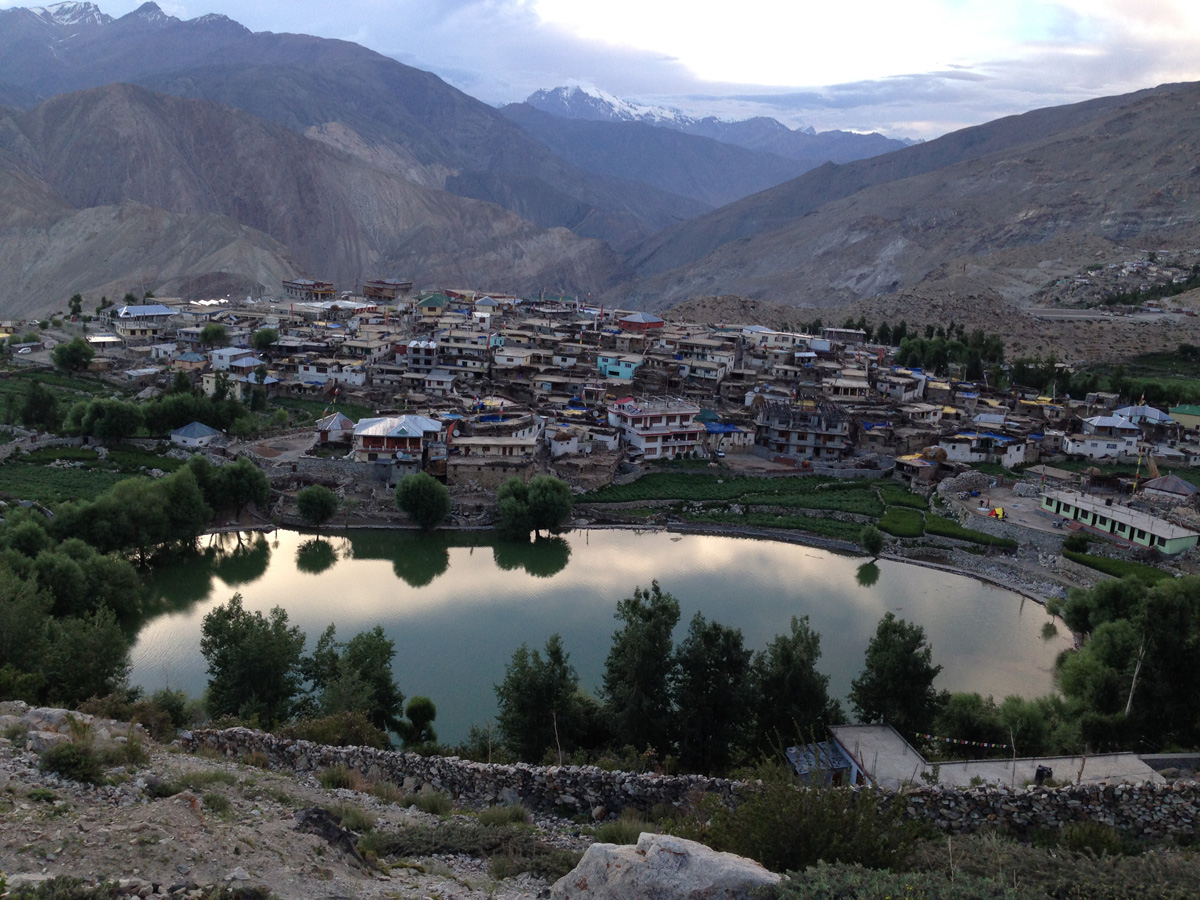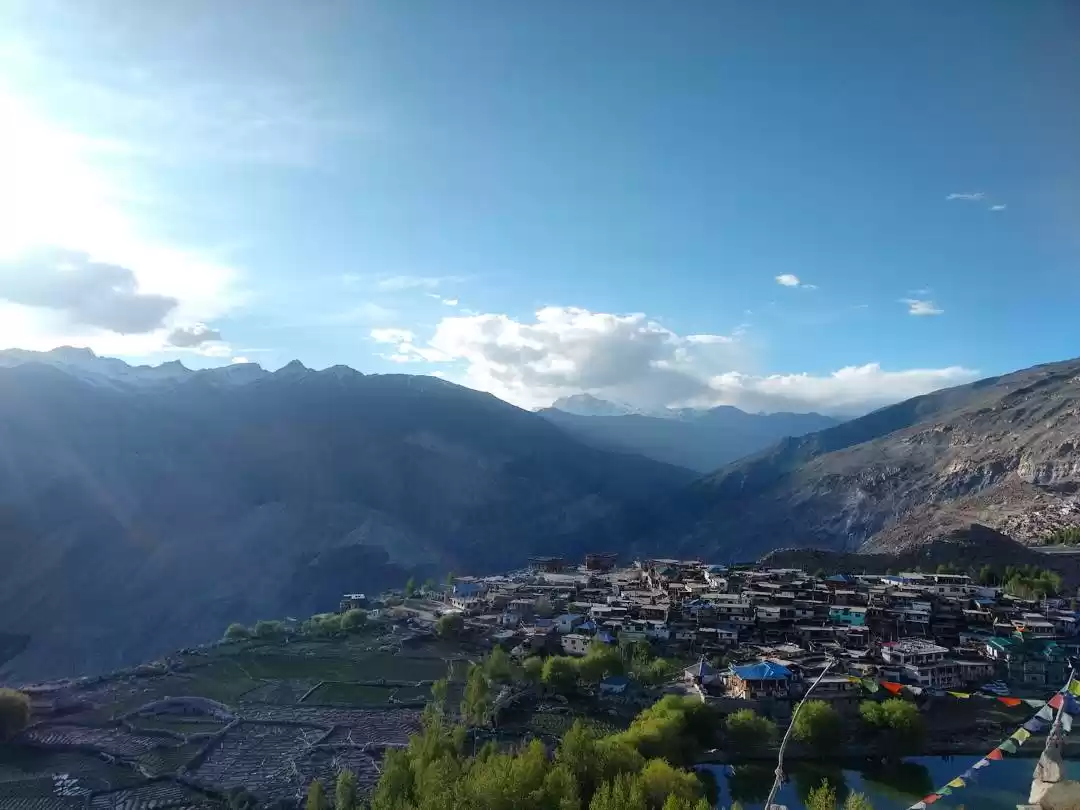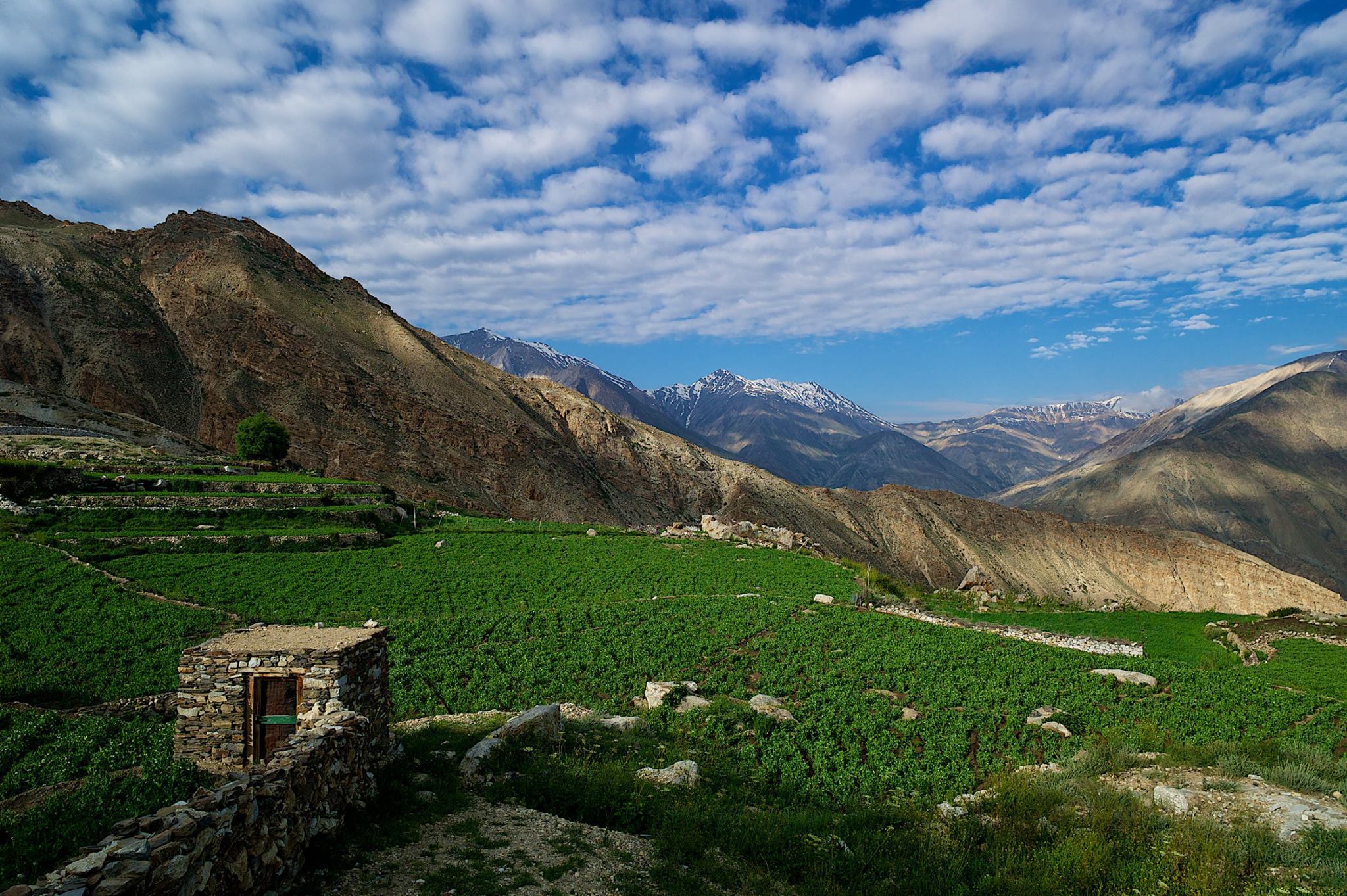Nako
Published on March 28, 2025
Nestled in the remote corners of Himachal Pradesh, Nako is a quaint village that feels like a slice of heaven on earth. Located at an elevation of approximately 3,600 meters (11,800 feet) in the Kinnaur district, this picturesque destination offers a unique blend of natural beauty, spiritual serenity, and cultural richness. Surrounded by towering snow-capped peaks, lush meadows, and pristine lakes, Nako stands as a testament to the untouched splendor of the Trans-Himalayan region. Whether you're an adventure enthusiast, a spiritual seeker, or someone looking for a peaceful retreat, Nako promises an experience that will leave you spellbound.
The journey to Nako Village is as captivating as the destination itself. Winding roads through rugged terrains, deep valleys, and high-altitude passes create a sense of anticipation and wonder. As you approach the village, the iconic Nako Lake , shimmering like a jewel amidst the mountains, greets you with its ethereal charm. Known for its tranquility and unspoiled landscapes, Nako has remained relatively offbeat, making it a haven for travelers seeking authenticity over commercialization. Let’s delve deeper into what makes Nako such a remarkable destination and why it deserves a spot on every traveler’s bucket list.

The Enchanting Beauty of Nako: A Feast for the Senses
Why Nako Stands Out Among Himalayan Destinations
When it comes to natural splendor, few places can rival the charm of Nako Village . Situated near the Indo-Tibetan border, this tiny hamlet boasts panoramic views of the Greater Himalayas, including majestic peaks like Kinner Kailash and Raldang. The sight of these towering summits, combined with the serene ambiance of the region, creates an atmosphere of awe and reverence.
One of the standout features of Nako is its vibrant seasonal transformation. In spring, the entire area bursts into life with blooming wildflowers and lush greenery. Summer brings milder temperatures, perfect for exploring the outdoors, while autumn paints the landscape in hues of gold and crimson. Even during winter, when heavy snow blankets the village, Nako exudes a surreal charm that feels almost otherworldly.
Nako Lake: The Crown Jewel of the Village
At the heart of Nako lies its most iconic attraction—the mesmerizing Nako Lake . This high-altitude lake, surrounded by snow-clad peaks and prayer-flag-adorned hills, is not only a visual delight but also holds immense spiritual significance. Locals believe that the lake is sacred and often perform rituals and prayers along its banks.
The crystal-clear waters of Nako Lake reflect the surrounding mountains like a mirror, creating a postcard-perfect scene. Visitors can take leisurely walks around the lake, enjoy birdwatching, or simply sit by its shores to soak in the tranquility. For photographers, the lake offers endless opportunities to capture stunning shots, especially during sunrise and sunset when the light dances on its surface.

The Ancient Nako Monastery: A Spiritual Haven
Another highlight of Nako is the Nako Monastery , a centuries-old Buddhist monastery perched on a hill overlooking the village. Also known as the Tangyud Gompa , this sacred site is a hub of spirituality and learning, attracting monks, pilgrims, and curious travelers alike. The monastery houses ancient murals, thangkas (Buddhist paintings), and statues of deities, offering a glimpse into the rich cultural heritage of the region.
Surrounded by prayer flags fluttering in the wind, the monastery exudes a serene atmosphere that invites introspection and peace. Visitors are welcome to explore its halls, attend prayer sessions, and interact with the resident monks to learn more about Tibetan Buddhism and its teachings. For many travelers, visiting the Nako Monastery becomes a transformative experience, leaving them with a deeper understanding of life and spirituality.
Cultural Riches of Nako: A Glimpse into Local Traditions
Kinnauri Architecture: Where Art Meets Nature
One cannot talk about Nako without marveling at its distinctive architectural style. The village is dotted with traditional wooden houses adorned with intricate carvings and vibrant motifs. These structures are built using locally sourced materials like deodar wood and stone, ensuring they blend seamlessly with the surrounding environment.
Each house in Nako tells a story—of resilience, craftsmanship, and community spirit. The flat roofs, designed to withstand heavy snowfall, double as storage spaces for fodder and crops. Inside, cozy interiors feature earthen stoves called bukharis that provide warmth during harsh winters. Exploring these homes offers a rare insight into the daily lives of the villagers, whose hospitality knows no bounds.
Festivals and Celebrations: Vibrant Reflections of Culture
Life in Nako revolves around festivals that celebrate nature, agriculture, and spirituality. One of the most significant events is Losar , the Tibetan New Year, which marks the beginning of the agricultural cycle. During this time, the entire village comes alive with music, dance, and elaborate rituals. Locals dress in colorful traditional attire, and monasteries host special prayers to invoke blessings for prosperity.
Another notable festival is Halda , celebrated to honor the deity of fire. Villagers gather around bonfires, chanting hymns and performing folk dances under starlit skies. Participating in these celebrations allows travelers to immerse themselves in the rich tapestry of Kinnauri culture, forging connections that transcend language barriers.

Local Cuisine: A Taste of Simplicity
No visit to Nako is complete without savoring its delicious yet simple cuisine. Staple dishes include siddu (steamed bread stuffed with walnuts or poppy seeds), aktori (a buckwheat pancake), and madra (a lentil-based curry cooked with yogurt and spices). These hearty meals are prepared using locally grown ingredients and reflect the resourcefulness of the villagers in adapting to high-altitude living.
Visitors staying at homestays or campsites often have the opportunity to participate in cooking sessions, learning age-old recipes passed down through generations. Sharing a meal with the locals is more than just dining—it’s an invitation to become part of their family.
Adventure Awaits: Trekking Trails Around Nako
Nako to Kinner Kailash Trek: A Journey Through Time
For trekkers, the Nako to Kinner Kailash Trek is a dream come true. This moderate-level trail takes you through some of the most stunning alpine meadows and dense forests in the region. Along the way, you’ll encounter diverse flora and fauna, including rare species of birds and medicinal plants.
Kinner Kailash, a sacred peak revered by Hindus, serves as the perfect endpoint for this trek. According to local legends, Lord Shiva meditated here, lending it an air of mysticism. Camping by the base of the mountain under a blanket of stars is an experience that words fail to describe adequately.
Exploring Beyond: Other Treks in the Region
While the Nako to Kinner Kailash Trek steals the limelight, there are several other trails worth exploring. The Nako to Tabo Trek offers a shorter yet equally rewarding route, passing through apple orchards and terraced fields. For those seeking a challenge, the Pin Valley Circuit provides a rigorous multi-day expedition with breathtaking views of the Spiti Valley.
Trekking in Nako is not just about physical endurance; it’s about connecting with nature and discovering hidden corners of the Himalayas that remain untouched by modernity. Each step reveals a new facet of the region’s beauty, leaving you humbled and inspired.

Practical Tips for Travelers: How to Make the Most of Your Visit
Best Time to Visit Nako
The ideal time to explore Nako depends on your preferences and tolerance for varying weather conditions. Summer (April to June) is undoubtedly the best season for first-time visitors, as the weather remains pleasant, and all trekking routes are accessible. Autumn (September to November) is another excellent time, offering clear skies and stunning fall colors.
Winter (December to February) transforms Nako into a snowy wonderland, attracting adventurous souls willing to brave sub-zero temperatures. However, note that road access may be limited due to heavy snowfall, and accommodations might be scarce.
How to Reach Nako
Reaching Nako requires careful planning, especially if you’re traveling from major cities like Delhi or Shimla. The nearest airport is Bhuntar (Kullu), approximately 350 kilometers away. From there, you can hire a taxi or take a shared cab to Nako via Reckong Peo and Sumdo.
Alternatively, you can opt for a train journey to Shimla followed by a scenic drive through the Sutlej Valley. While public transport options exist, hiring a private vehicle ensures greater flexibility and comfort.

Accommodation Options in Nako
Nako offers a range of accommodation choices catering to different budgets. Homestays run by local families provide an authentic experience, allowing you to interact closely with the villagers. For those seeking luxury, boutique hotels and eco-friendly resorts offer modern amenities without compromising on the rustic charm.
Camping is another popular option, with several operators organizing tented stays near Nako Lake. Imagine falling asleep to the sound of flowing water and waking up to the sight of snow-capped peaks—it doesn’t get better than this!
Essential Packing List
To ensure a smooth and enjoyable trip, pack wisely based on the season and activities planned. Some must-haves include:
- Warm clothing (jackets, thermals, gloves, and woolen caps)
- Sturdy trekking shoes
- Sunglasses and sunscreen
- First-aid kit
- Camera for capturing memories
- Reusable water bottle
Why Nako Should Be on Every Traveler’s Bucket List
In today’s fast-paced world, finding a place that offers peace, simplicity, and raw natural beauty is becoming increasingly rare. Nako checks all these boxes and more. It’s a destination that invites you to slow down, breathe deeply, and reconnect with what truly matters.
From its enchanting landscapes and rich cultural heritage to thrilling trekking trails and warm hospitality, Nako has something for everyone. Whether you’re embarking on a solo adventure, planning a romantic getaway, or traveling with family, this hidden gem promises experiences that will stay with you forever.
So why wait? Start planning your journey to Nako today and discover the magic of the Himalayas firsthand. Share this guide with fellow travelers and inspire them to explore one of India’s most underrated treasures.

Frequenlty Asked Quetion About Nako
Where is Nako located and what makes it unique?
Nako is a picturesque village in Himachal Pradesh's Kinnaur district, situated at 3,662 meters near the Indo-Tibetan border. It's famous for its ancient Buddhist monastery, sacred Nako Lake, and stunning Himalayan views.
What is the best time to visit Nako?
The ideal time is May to October when the weather is pleasant and roads are accessible. Winters (November-April) bring heavy snowfall, often blocking routes.
Do I need a permit to visit Nako?
Yes! Indian travelers require an Inner Line Permit (ILP), available at Reckong Peo or Shimla. Foreign nationals need a Protected Area Permit (PAP).
How do I reach Nako from Delhi?
The route is Delhi → Shimla → Kalpa → Reckong Peo → Nako (600 km, 16-18 hours). Buses and shared jeeps are available from Shimla to Reckong Peo, followed by a taxi to Nako.
What are the must-visit attractions in Nako?
-
Nako Monastery – A 1,000-year-old Buddhist complex with ancient murals
-
Nako Lake – A sacred lake surrounded by willow trees
-
Tabo & Gue Mummy – Nearby villages with historic monasteries
-
Tashigang Village – Offers panoramic Himalayan views
Is there mobile network or internet in Nako?
BSNL works intermittently, while other networks have poor connectivity. No reliable internet is available, making it a true digital detox spot.
What kind of accommodation is available in Nako?
Basic homestays and guesthouses with minimal amenities are available. For a unique experience, try staying in a traditional Kinnauri house.
Can I visit Nako in winter?
Only if you're prepared for extreme cold and road closures. December-February sees heavy snowfall, making travel difficult. Some homestays remain open.
Is Nako safe for solo travelers?
Yes, but due to its remote location, it's best to travel in daylight and inform someone about your plans. Locals are friendly but medical facilities are limited.
What should I pack for a trip to Nako?
-
Warm layers (nights are freezing even in summer)
-
Sturdy trekking shoes
-
Power bank & flashlight (frequent power cuts)
-
Cash (no ATMs or card payments)
-
Basic medicines (nearest pharmacy is in Reckong Peo)
